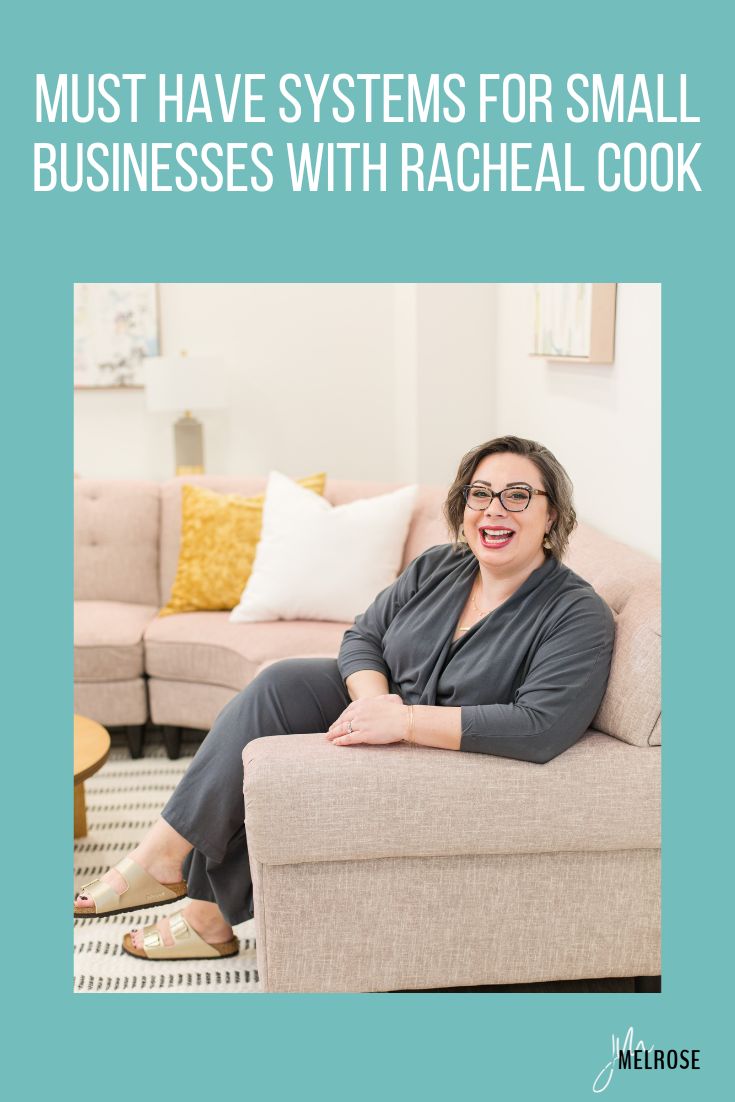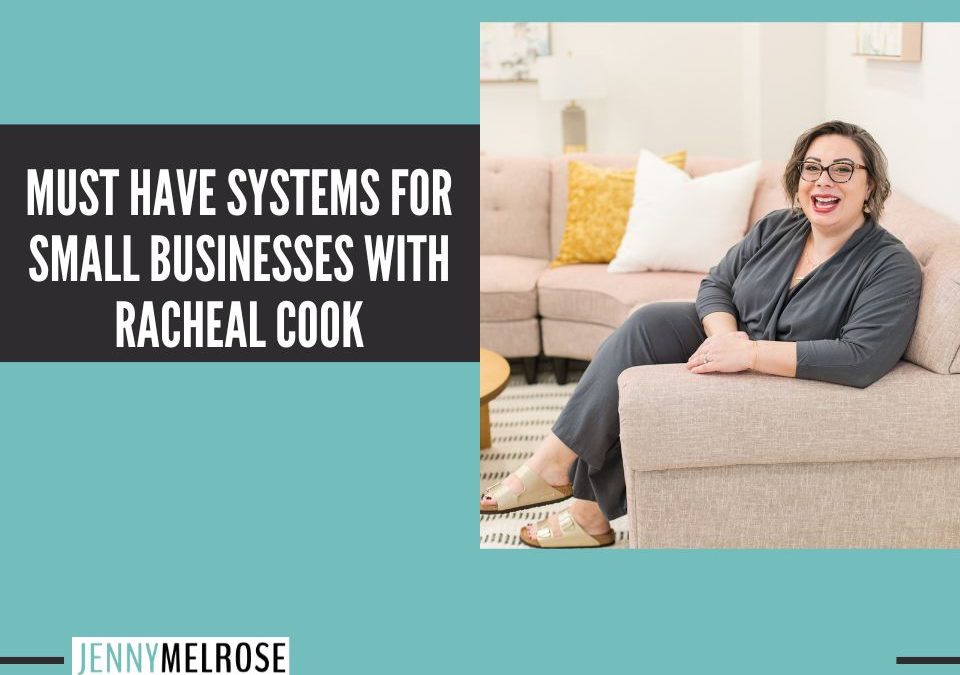Discover essential systems for small businesses that are needed in order to improve your overall business.
IE 397: Must Have Systems for Small Businesses with Racheal Cook

Racheal Cook is the CEO Collective’s founder and host of the “Promote Yourself to CEO” podcast.
She has been working with small business owners her entire career. She started her consulting business in 2008/2009 when she was burnt out from her traditional consulting career. She had been working with larger businesses with hundreds of employees and wasn’t inspired by many of the companies she worked with.
After burnout and chronic health issues, she took a leave of absence. During that time, her yoga teacher mentioned that she needed help with the studio. That was her “lightbulb” moment when she realized there were owner-operated businesses that needed a level of support and expertise that she could provide but couldn’t afford a large consulting company.
Some of those agencies were not friendly to women and didn’t understand the complexities of running a small business while taking care of a family, being a caregiver, and the challenges that most women deal with. Women start businesses because they need more flexibility and freedom and the old way of hustle and grind doesn’t fit.
Over the years, she has evolved the business to work with multiple businesses and industries. In 2020, she pivoted to the CEO Collective, a 12-month immersive mentorship and mastermind that helps business owners with strategy, systems, support, and achieving their goals to build a sustainable and scalable business.
She has seen many small businesses think of their businesses as a replacement for a paycheck and not as an asset. One of her goals is to help business owners realize they can create a sellable business and use that as the next step forward in their lives to help them have more freedom and financial independence.
Having the right systems in place can make a difference in your business, the time you have for yourself, and the creative space to be able to create.
How can we gain more control in our small businesses?
Women often know they have too many plates spinning and know something is going to drop. How do we fix this?
Racheal has studied the research and data for women in business and it bothered her that most business owners are not making enough revenue. Only 12% are breaking the $100,000 gross revenue. That is not their take-home pay. Only 3% are breaking the 7-figure mark.
We are not building sustainable businesses. If your business is feeling out of control like you are herding kittens, business is out of control, and you cannot head in one direction, it is easy to believe that the first thing you have to do is increase revenue.
The research shows us that if all you focus on is increasing your revenue, marketing and sales activity, you are creating more chaos for yourself. You have amplified the things that feel chaotic in your business.
The first thing you need to do is to regain control of your business by implementing systems that streamline and simplify your business as much as possible. Racheal has a “90-day CEO Operating System.” There are clear systems set up to regain control of the business.
For every offer, you need to have a marketing system, a sales system, and a delivery system. Those three systems are called the “Client Growth Engine.” Once those systems are together and working cohesively, you have a way to bring in new clients and retain the clients that you have.
Retention is a big thing that companies often miss. They are constantly trying to replace the clients that are leaving.
Racheal has business owners think about how they can retain clients and stay long-term and/or become repeat clients. By maintaining retention, you can do less marketing and sales because you are increasing your lifetime customer value and time they are spending with you. This is building your client base.
One good example is a hairstylist. Once we find one we like, we go to them consistently. A good stylist will build a client list of 100-200 people who see them every three months. That is an easier business to run than if you are always trying to get new clients and would need a much larger number of clients to make the same amount of money.
The first framework you set up should have a goal of retaining your clients for life. Make sure your marketing and sales systems are attracting clients that are perfect for you. How are you making sure your client delivery and the experience they have with you will retain them and make them repeat buyers who will continue to work with you long term?
This is the first big framework Racheal encourages people to put into their business because it simplifies everything and makes it easier to repeat once you get the client growth engine dialed in.
If you are an online educator, how do you retain clients after you have helped fix their problem?
This is when you want to think about your offering suite. Racheal is an “Apple Girly” and has many Apple products, including an iPhone, iMac, multiple iPads, and multiple MacBook Pros. She likes them because everything works together seamlessly and her information syncs between the products.
When you think of an offering suite, you want to think like Apple. Once people are invested in you and your solution, you want them to know that when they upgrade or make a repeat purchase, it isn’t even a question for them. They are going to buy what they love and trust…and that should be you.
If you are selling your expertise, you can do this easily by mapping out the customer’s journey.
You don’t have to do this all at once. You need to grow with your clients. Some people try to guess what their clients need instead of allowing people to use their first product, get and prove the results, and then evaluate what their clients need next.
It could take a couple of years to develop these offers and they can come in many different offers.
Racheal has an offering suite that is repeatable and upgradeable. Once people purchase the first thing, they can purchase it repeatedly. Then, there is a logical, next step that allows customers to continually upgrade their level of service with her company.
For example, she has a printed planner, the 90 Day CEO planner at a low price point of $35 that comes with training. Her entire framework is called the 90 Day CEO Operating System and that is woven through all of her offers.
Once people buy the planner and use it, they start to see results and then they buy more planners. The upgrade is the one-day CEO Retreat which shares the 90-day methodology to help them create a 90-day plan that integrates the client growth engine. Racheal brings these together to layer another piece of the puzzle.
She has launched over 60 of these retreats. The first one she did for fun, not knowing how it would go, but people asked if she would be doing it the next quarter. At the time, she didn’t have a plan but said “Yes!” Some people have done as many as 20 of them because they keep showing up to the CEO Retreat quarter after quarter, year after year.
Even though they are going through the same process, it is the accountability of doing the work and being able to get out of the day-to-day business for a short period. One of the biggest reasons people don’t work on the business is that they are so enmeshed in the day-to-day minutia.
Customers can choose how often they want to participate in the 90 Day CEO Retreats or they can upgrade to the CEO Collective: a 12-month group coaching program. This is part mastermind, part group coaching, access to all of her trainings, a full year of planners and retreats, and a full year of support with a dedicated mentor that provides accountability.
Racheal has made each step of the process and offers something repeatable, has a next step, and works together with her framework.
Often, her clients come up with offers that don’t fit together and are not built around a journey that allows the customer to grow with them. If you have a bunch of offers, it can lead to a confused mind. A confused mind says no.
If people don’t know what you do and you offer a smorgasbord of options that don’t show the customer what you do/offer, they are going to say no.
We all have decision fatigue and are overwhelmed with all of the options. If you can simplify your offerings around a core message and process you are taking people through, you are like Apple products that fit together. People can purchase, upgrade, and know that everything they are doing with you is cohesive. That is a game changer.
The Customer Journey – You have to understand where your people are coming in, where they are looking to go, and how you can continue to solve that problem.
Product Offerings – The continual journey can apply to most customers and you can create things that they can repeat annually. Products can be formed after the first one and you understand your people better.
As a small business owner, when should systems be implemented in business?
Racheal is a very systems-oriented person. She has checklists for everything. She also recognizes that this is not how every brain works.
The first thing is to recognize is when something needs to be repeated. If you are doing a task in your business that is going to be repeated, that is an opportunity to make a system for it. This would be documenting the steps it takes to do something so that you can do it again.
Each of us has stuff in our business that we are doing over and over again. We get slowed down when we are the ones who are doing it over and over again and do not create a process that someone else can follow.
Start by auditing your time and tracking what you do over a couple of weeks. Highlight or circle the items that you know will be repeated. Become aware of the things you will do repeatedly. The next time you do the highlighted items, start documenting the steps.
Racheal’s favorite way to do this is to record herself. She uses Loom and they now have an AI feature that will summarize the recording. She now has a training vault for every process for her team. You are putting in place a documented process that someone can use.
You can start with the things that you want to get off your plate first and the things that are taking a lot of time. For example, you might choose content creation. Both Jenny and Racheal have a podcast and that can be time-intensive.
You can brainstorm all of the steps to get a podcast published. Your steps might be brainstorming ideas, scripting the podcast, recording, editing, publishing it to your podcast host, creating show notes and adding those to your website and podcast host, and then announcing it on social media and your newsletter. That might be a twenty-step process.
When you outline the process, you can look at the steps and figure out what you need to be responsible for and what you can delegate to others. Then, you can share with them exactly how you want this done.
For Racheal’s podcast, she only records it. Her team handles the rest of the entire podcast process for her. They manage every part of publishing it for her (and she doesn’t even know when they are released!). Because the process is in place, it frees up bandwidth for Racheal to do the next most important thing that only she can do.
Systems help you close yourself to make your time as the CEO of your business the most valuable time. You want to be spending your time on CEO-level tasks, the $1,000 tasks, or $10,000 tasks instead of tasks that someone else can step in and handle for you.
What areas of our business should get systematized first?
Many owners have been doing all of the tasks by themselves for so long that they need to figure out where they need to spend their time.
Racheal uses a CEO Scorecard to divide up diverse types of tasks into different buckets. The $ 10-an-hour bucket is going to include tasks that are more administrative and customer service-related. The $ 100-an-hour bucket includes more skilled tasks but are typically repeatable, like editing a podcast or creating show notes.
Then, there are CEO-level tasks that are $1,000 or $10,000 an hour tasks. These are sales-related and front-end market attraction tasks. The business owner should be focused on the highest-value tasks they can as the lower-value tasks are not the best use of your time.
All of us have admin tasks we need to do, such as bookkeeping. If you are doing bookkeeping yourself, you are spending time that should have been spent on growth-oriented tasks. It is inexpensive to get these tasks done.
When an owner says that they can save money by doing those tasks, Racheal explains that they are costing more money because your value as the CEO of your business is $1,000 or $10,000 an hour. You are the one that grows the business.
Get the administrative tasks off your plate. If you are doing your bookkeeping, invoicing, or manually scheduling things, checking the inbox (which is someone else’s agenda for you), you need to get support. It might feel like an expense but you are buying back your time so you can put it into higher-value tasks.
The first things to get off your plate are admin, operations, customer service tasks, and then get help with marketing and sales. If you can hire someone for marketing to help you be more consistent, that will be a valuable use of your time.
Are there any tools that you recommend for systematizing your business?
You will need to look at your specific business to see what applies the most to you. There are so many inexpensive tools that make life so much easier. If you are a coach, you might use Paperbell; an online tool that manages billing, invoicing, scheduling, notes for your clients, and works as an assistant. You just set it up once and it does the work.
Some service providers use Dubsado or Honeybook. Once you set it up, you can send out proposals, and invoices, and handle client management all within one tool.
If you are in the healthcare industry and need to be HIPPA compliant, you might use Jane. Many therapists and chiropractors use this tool.
These tools cost money but you have to value your time enough to realize that paying for these tools can be well worth it if it saves you 25 hours a month.
Assess to see what tools you need. Do you need a scheduling tool? Something to manage your invoices or clients?
Sustainable Success Series
Racheal offers a training called The Sustainable Success Series.
In this 3-part training series, we dig into the research to discover the core areas you want to get control over and start to systematize. You look at the 90 Day Operating System Framework, a research-backed, scientific approach to grow your business. You also evaluate your growth edge as the CEO which you need to lean into as you put systems in place. Your business won’t grow past your level of leadership.
If you want to have a successful business, you want to learn to embrace the discomfort and focus on certain things to get where you want to go in business.
ACTION ITEMS
- If you liked this episode of Influencer Entrepreneurs, please subscribe and leave a fabulous review!
- Ready to go deeper into your business? Join the Insiders Group at the special rate for podcast listeners.


